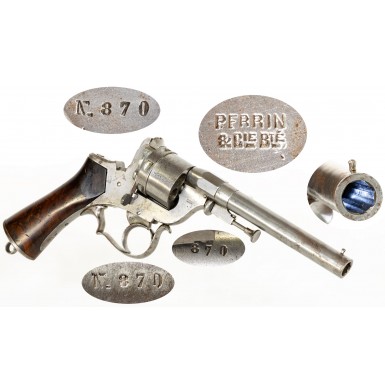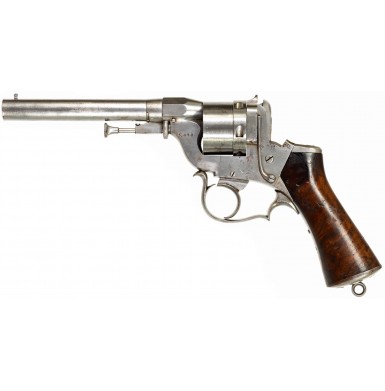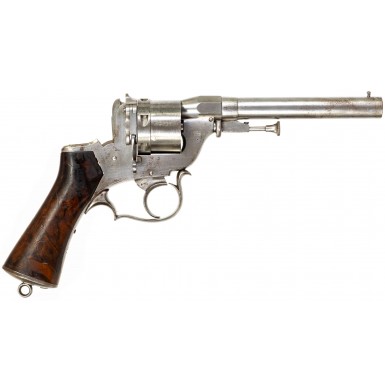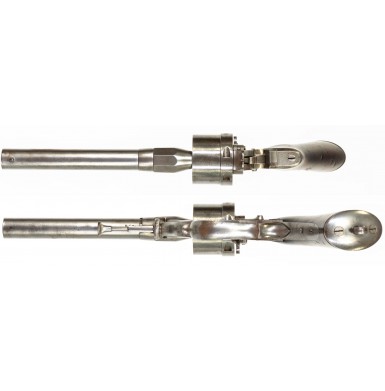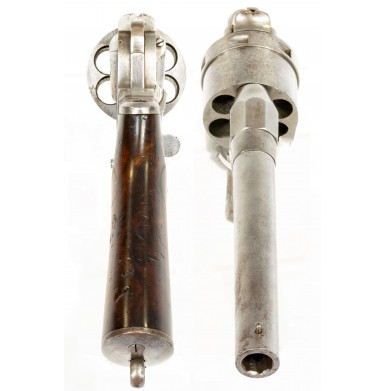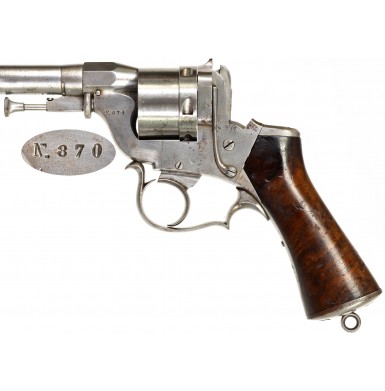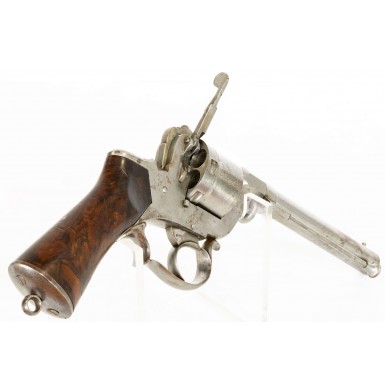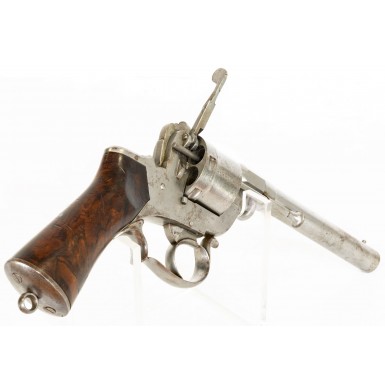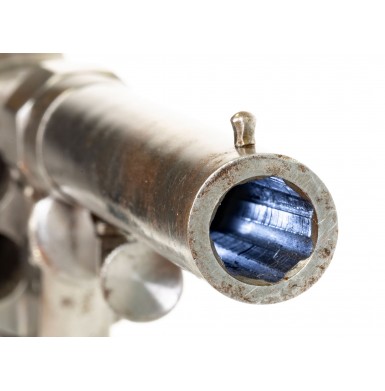Fine Civil War Era French Model 1860 Perrin Revolver
- Product Code: FHG-3520-SOLD
- Availability: Out Of Stock
-
$2,250.00
Next to the Model 1860 Pidault-Cordier Revolver (aka “Raphael”) revolver, the Model 1859 Perrin Revolver is probably the least often encountered of all American Civil War imported handguns. Like the Raphael, the Perrin was a French designed, self-contained, cartridge revolver with a double action lock work and a 6-shot cylinder. While the Rafael was a “traditional double action” in that it could be fired in either single action or double action modes, the Perrin was what would be called a “double action only” revolver today, with the action only being actuated by the long, heavy pull of the trigger, and with no facility to cock the hammer manually.
The Perrin fired a very advanced 12mm (approximately .45 caliber), internally primed, self-contained metallic cartridge. The cartridge had a thick rim and while the primer was not visible from the outside bottom of the casing as it is with modern center fire cartridges, it was a center fire design. The patent covering the revolver design, but most especially the cartridge design, was granted in France to Perrin & Delmas in 1859. As noted, this gun was strictly a double action design, with a spurless hammer, similar to the Model 1851 Adams patent percussion revolvers. In fact, the gun featured an Adams style safety spring on the left-hand side of the frame. By lightly depressing the trigger, and thus slightly lifting the hammer from the rear of the cylinder, the safety spring would automatically make a small extension enter the frame, creating a hammer block that kept the hammer from contacting the cartridges. This also unlocked the cylinder to rotate freely for loading or unloading. Pulling the trigger to fire the gun automatically released the safety, with it rebounding out of the way of the hammer, allowing the falling hammer to strike the cartridge in the cylinder’s chamber.
The Perrin had an interesting hidden ejector rod that was used to eject the empty cases from the cylinder. The rod was stored within the center portion of the cylinder arbor, and could be withdrawn, and then rotated via a cam on the barrel, to align it with a cylinder chamber on the right-hand side of the gun. This placed the rod in the correct position to push the empty cases out of the chambers. This storage system protected the slender, and somewhat delicate, rod from damage when it was not in use, and allowed for a more streamlined design without an ejector rod or housing mounted on the frame or barrel of the revolver. The ejector rod also kept the cylinder arbor pin in place when it was being stored and taking the ejector rod out of storage freed the arbor pin to be withdrawn from the frame, allowing the cylinder to be removed. This same system would be employed less than a decade later on several of the early P Webley & Sons cartridge revolvers, like their Royal Irish Constabulary (R.I.C.) and Bull Dog models.
Perrin revolvers were marked with the patentees’ name and with a serial number on the major components. Collectors have separated the Perrin revolvers into three “Types”, which appear to be chronological in their evolution. Both Types I and II have open top frames, while the Type III has a top strap. The variations between these three types are further indicated by the type of loading gate system. Type I gates are rather thin and are hinged at the top, swinging outward and upward. Type II gates are somewhat thicker and are also hinged at the top but swing to the rear of the revolver to open. The Type III gate is thicker and more robust and is hinged at the bottom, swinging down and away from the frame.
It is worth noting that there is little good information about the Perrin revolver in print in English, and sources vary as to the actual model designation, Model 1859 or Model 1860, as well as to their actual caliber, 11mm or 12mm. While most sources in the US have long referred to the gun as the Model 1860, the recent publication French Service Handguns by Eugene Medlin & Jean Huon refer to the pistol as the Model 1859 and as they seem to be the most definitive word on the subject, I will defer their opinion. The issue of caliber; 11mm versus 12mm, is somewhat more problematic. In this case, Medlin & Huon come down on the 11mm side of things. Measuring extant examples reveals that the chamber mouths are typically about 12mm while the bores measure approximately 11.5mm. This suggests the reference to 12mm really establishes the outside diameter of the case, rather than the diameter of the bullet. As this was a common way to establish “caliber” during the period (case diameter versus bullet diameter) I will continue to use the 12mm designation. This system of measuring and naming cartridges based upon their case diameter rather than bullet diameter is why the “.38 Special” uses a .357” diameter bullet. The original name for .38 caliber revolver cartridges is derived from the case diameter, and we have not seen fit to discontinue calling .357 caliber revolvers “.38s”. It is further worth noting that according to the Springfield Armory Museum Collection Record, regarding Perrin revolvers: “We have of this writing five Perrins in the collection. No two are quite alike, having minor variations in rear sights, grips, loading gates and rebating of frame as well as barrel lengths.” Other authors have noted that barrel lengths tend to vary between 5 ½” and 6 ½” and that the earliest production guns have variations in rifling with 4, 6, 8 and 9 groove examples having been noted. Eventually it appears that the 6-groove system was settled upon as standard. The majority of the revolvers were finished “in the white” with bright polished metal and had smooth one-piece walnut grips. However, some examples are known with special finishes, including blued, nickel plating (a very new technology in the 1860s), as well as gold damascene. Checkered grips are not uncommon either, although smooth wood certainly seem to predominate on extant examples.
We can document the sale of 550 Perrin revolvers, from a contract for 1,000 total revolvers, to the US Government by arms speculator Alexis Godillot. Godillot listed “New York & Paris” as his business addresses and delivered the revolvers at a price of $20.00 each, including 50 rounds of the proprietary Perrin ammunition with each revolver. Godillot made his initial delivery of 350 Perrin revolvers on January 6, 1862, delivered another 100 on March 28, 1862. The final 100 Perrins that he would provide were delivered on May 31, 1862. Interestingly, the Holt-Owens Commission, which had been established in early 1862 “to audit and adjust all contracts, orders, and claims on the War Department in respect to ordnance, arms and ammunition,” actually cancelled Godillot’s contract for Perrin revolvers in April of 1862, due to his inability to deliver them in a timely fashion. However, they did allow the final delivery of 100 guns on May 31, even after the cancellation of the contract, due to the fact that “the arms are needed by the government, and are of good quality, and of reasonable price.” On May 31, he also delivered 1,500 Lefaucheux pin fire revolvers, and no further deliveries of Perrins are noted in US Ordnance documents. US Ordnance Department documents show that 1 Perrin was in storage at the New York Arsenal on December 31, 1862. An additional 249 Perrins were in storage in at the Ordnance Depot in Louisville, KY on the same date. This indicates that the other 300 pistols that had been delivered were likely in the field and in use during this time frame. Ordnance returns of November 5, 1864, show that the single Perrin at the New York Arsenal was still there, and that 187 Perrin’s were in store at the New York Agency. It is not clear what happened to all of the Perrin revolvers that the Ordnance Department purchased, but on June 19, 1901, the New York Arsenal sold 368 Perrin revolvers to Francis Bannerman and Company for $0.2765 (yes, only 27.65 cents) each. It is likely that the other 182 revolvers were lost or stolen during or after the war, with some likely going home with the soldiers to whom they were issued. Due to their proprietary ammunition, these arms were probably of limited utility in a civilian world where the French made cartridges were not likely to have been readily available. While no specific list of Civil War used examples by serial number is known, from those that have a “Civil War” association it appears most have serial numbers under 1,000 and all are of the open frame, Type I or Type II variants. Much like the Perrin’s contemporary, the Lefaucheux revolver, it appears deliveries were of available guns on hand and no systematic attempt to keep the deliveries within a specific serial number block or range was attempted by the furnishers.
This Model 1859 Perrin Revolver is in about FINE overall condition. The right side of the frame, forward of the cylinder is marked in two lines:
PERRIN
& CIE BTE
indicating the gun was patented by Perrin & Company. On the left side of the frame is the serial number. Interestingly the often-encountered Perrin “sunburst” motif and the word “Paris” are not present, markings that often appear on Perrin revolvers. The serial number on the frame reads N. 870, and that number appears throughout on the numbered parts. The cylinder is clearly marked N. 870 on its side and is otherwise unmarked. The same serial number also appears on the bottom of the barrel, hidden by the ejector rod-cylinder arbor combination. All of the markings remain quite clear and legible. Like most examples of Perrins, this one is finished in the white. The bright metal has dulled and oxidized with time, leaving the metal with a duller steel patina. The metal shows scattered patches of surface oxidation and of dark age discoloration. The metal is mostly smooth, with some scattered areas of very light surface roughness and some small patches of very light pinpricking. The double action mechanism works very well and is quite crisp, even though the trigger pull is rather heavy and slightly gritty. The revolver remains mechanically excellent in every way, and times, indexes and locks up exactly as it should. The original Type I top-hinged thin loading gate, which is the weakest point of the design of this gun, is present and functions perfectly, snapping securely into position when closed and rotating upward when opened. Amazingly the gate shows no signs of replacement or repair. The Adams style safety spring is present on the left-hand side of the frame as well. When a Perrin is located, it is not uncommon to find both the loading gate and this safety spring missing, damaged, repaired or replaced. In this case both pieces are complete and original. The original front sight, which is often damaged or missing, is in place and remains in very good condition. The steel combination post and bead are slightly bent, but other than that are no worse for the 150+ years of the revolver’s life. As previously mentioned, Perrin revolvers were manufactured with barrels that varied in length between 5 ½” and 6 ½” in length. The barrel of this one has a barrel that is nominally 6 ½” long. Although this is revolver with a high enough serial number where a 6-groove bore would be expected, it is rifled with a 7-groove bore. The 6-groove bores seem to become somewhat common around the 6XX serial number range, so this is likely one of the last of the non-standard bores to have been produced. The bore is in about VERY GOOD condition and is mostly bright with very crisp and deep rifling along its entire length. The bore shows light to moderate pitting scattered along its length, along with scattered oxidation and discoloration. The original ejector rod in the center of the cylinder pin is present and the rotating cam allows it to function correctly. The rod’s head is of a somewhat uncommon shape, being flat and recessed rather than acorn shaped, but this might have been another transitional or experimental idea, like the uncommon rifling pattern. The head of this ejector rod is actually more practical than the more commonly encountered acorn shaped head, as it makes it much easier to seat the rod properly in the arbor after use. Pulling out the rod and rotating it to the right side of the gun allows it to be used to eject the spent cartridge cases. The one-piece smooth walnut grip is in about FINE condition, with no chips or breaks or repairs. Perrin’s appear with both checkered and smooth grips, with no particular rhyme or reason to which variant is encountered, although smooth grips appear to be somewhat more common. This variant has a particularly attractive and well figured piece of walnut used for the grip and it is quite attractive. Although solid and complete the grip does show scattered bumps, dings, and surface mars from carry and use. The original, small diameter, lanyard ring is present on the iron butt cap and swivels freely as it should.
Overall, this is a very nice, crisp, and well-marked example of one of the two rarest of the US import martial revolvers used during the American Civil War. While not commanding the price or the of the renown of the LeMat, far fewer of these revolvers exist these days. Like the Raphael, Fredrick Todd’s seminal work American Military Equipage 1851-1872 lists the Perrin as being a possible secondary Confederate purchase, as well as a US purchase. Unfortunately, Todd provides no substantiation for his claim. Additionally, the requirement to use the proprietary self-contained Perrin metallic cartridge ammunition that could not be produced in the south makes this assertion even less likely to be true. It is fairly rare to see one of these revolvers on the market, let alone in a collection. Many of the finest collections of Civil War revolvers simply do not have a Perrin in them. Here is a great chance to own a very nice displaying example of a very rare gun. The gun is 100% complete, correct and fully functional. This is a revolver that your collecting friends are quite unlikely to have in their collections and will be a very nice addition your advanced collection of Civil War era secondary martial pistols.
SOLD
Tags: Fine, Civil, War, Era, French, Model, 1860, Perrin, Revolver

